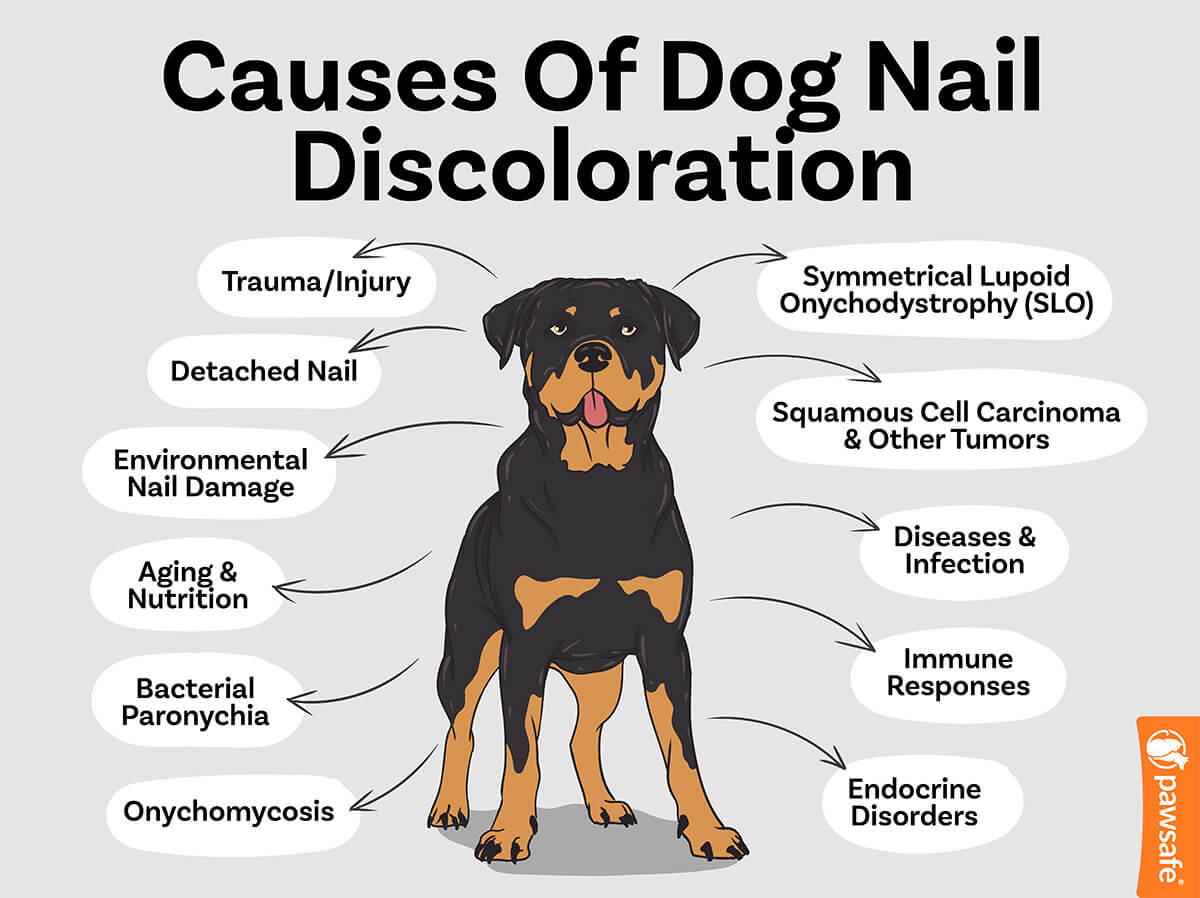
Many dogs have naturally black nails, but if you see a normally white dog nail turning black, then there is usually a cause for concern. It’s worth paying attention to your dog’s nail color since changes in color can indicate fungal infections, allergies, and even an autoimmune disease.
Increasingly, as dog owners, we are becoming aware of how to care for our dogs in a way that previous generations did not. From brushing our dog’s teeth, to nail trimming with a good pair of dog nail clippers, we are learning that our dog’s health and well-being are all in the details. Following a proper trimming frequency guide can help prevent nail problems.
So let’s take a closer look at what dog nail colors can tell us.
Table of Contents
What Color Should Dog Nails Be?
The natural color of a dog’s nail depends on the pigment around the paw and toe area. Typically, if your dog has white or light coloring around their paw, the nail should be transparent. You should also clearly be able to see the thick white area inside called is quick.
If your dog has dark pigmentation in the skin and fur around their toes, they will have black nails. This is tricky because you can’t see the quick in these cases when you trim.
If you’re wondering, “My dog’s nails are black…how do I cut them?” see our article on how to trim a dog’s nails at home, where we discuss nail clipping in detail.
In short, black nails should be trimmed carefully to avoid damaging the quick. The PawSafe Nail Clipper comes with a handy LED light you can use to shine through a dark nail to help you spot where the quick is.
But what happens when white nails start to change color?
Why Would A Dog Nail Turn Black?
Nail discoloration, where the nail turns red, brown, or black, is usually due to an injury with internal bleeding and bruising under the nail. But it can also be a fungal, bacterial, or protozoal infection. Sometimes it happens because of tumors or damage that allows dirt and debris to collect under the nail.
Dr. Ariane Neuber[1] outlines several diseases that affect the dog’s nails, including leukonychia, where a dog’s nails turn white. However, most conditions cause the nail to darken as a secondary symptom. Let’s take a look.
Dog Black Nail Treatment & Common Causes Of Dog Nail Discoloration

Trauma & Injury
An injury is the most common cause of a dog’s nails turning black. Bruising under the nail will turn the color darker. Initially, it will turn red from dark blood forming inside dog nails. But as the hemoglobin breaks down into methemoglobin and hemichrome, the nails change color from red to black.
Additionally, most bacterial and fungal infections that cause nails to turn red, brown, or black start with an injury or trauma that allows the pathogen to infect the tissue around the nail or the keratin itself.
This could happen from dogs digging excessively, running on hard ground such as asphalt, or even because of pet parents clipping nails too often. A major problem is clipping nails incorrectly, such as using human clippers that can cause the nails to crack or break.
Older dogs often have more brittle nails and longer ones if they aren’t regularly trimmed. This makes seniors particularly vulnerable to nail issues.
Not only does a damaged nail allow bacteria and other nasties to infect the tissue underneath, but it also causes your dog to lick. The constantly moist environment encourages yeast and other infections to thrive.
Detached Nail
Sometimes, a nail will become discolored and dark because it has completely detached or been ripped loose from the nail bed or quick. The dead nail will blacken or change color as it loses nutrients from the blood vessel and collects dirt from the environment.
Environmental Nail Damage
Elements in your dog’s environment can damage their nails enough to cause blackening or discoloration. This can include dry environments that cause nails to split and crack or walking on caustic agents such as mildew stain or rust removers.
Steps to Treat a Dog’s Broken or Damaged Nail
Although it may not seem like an emergency if you notice your dog has a cracked or broken nail, it’s best to visit the vet to prevent infection that can cause a dog’s nails to turn black. Treatment for a broken nail includes:
- Cover the nail with a bandage or gauze. Stop any bleeding by applying pressure.
- Your vet may need to remove the damaged part, especially in the case of a completely detached nail.
- They should then apply a topical antibiotic and antimicrobial ointment.
- Nail injuries are extremely painful, so your dog will need pain medication.
- Your dog may need a cone to prevent them from licking the broken nail, causing a secondary infection, or delaying healing.
If you clipped the nail bed while trimming your dog’s claws and are worried, see our article on how long it takes for a dog’s nail quick to heal.

See The Quick. Clip With Confidence
LED light and razor-sharp blade help you avoid over-cutting and finish trims fast with less mess.
Shop Now 👉Safe Trim Guarantee • 90-Day PawSafe® Promise
Aging & Nutrition
Dogs’ nails can change as they age. Typically, newborn puppies are born with transparent nails that darken as they age. Other dogs can have nails grow lighter or darker in their senior years.
Nutrition is a vital aspect of nail health. Deficiencies can cause a variety of nail issues. A common one is zinc-responsive dermatoses. Northern sled-dog breeds, particularly the Siberian Huskies and Alaskan Malamutes, can have type 1 of this condition and will need treatment as it is hereditary.
However, many large breeds are prone to zinc deficiencies growing, especially as other nutrients like calcium tend to bind with zinc in the gut and prevent it from being absorbed. Treatment can involve zinc supplementation, and since it often comes with a secondary yeast infection, your dog may also get corticosteroids.
The omega-fatty acids, EPA & DHA, found in fish oil are also essential and part of the treatment for SLO discussed below. Other nutrients necessary for nail health include biotin, iron, and vitamin B12. Without enough of these, nails become weak and turn gray, black, or brown.
Bacterial Paronychia
Bacterial Paronychia is where the nail and surrounding tissues get infected, usually after a nail injury. It’s quite rare but hard to treat. It usually takes a course of topical treatments, anti-inflammatories, strong antibiotics, and antifungal treatments. But in severe cases, a vet may need to remove the nail or even the toe surgically.
Symptoms include:
- Pain & limping;
- Swelling around the nail;
- Discharge, crusting, or pus coming from the nail;
- Reddening, browning, or blackening around the base of the nail;
- Excessively licking one toe; and
- Visible bone in severe cases.
Onychomycosis
This fungal condition is also quite rare but may be diagnosed too often. It is tough to cure and grow out the diseased part of the nail. The nail usually gets reinfected if pet owners don’t keep up the treatment. The claws typically become thicker, discolored, and malformed. Learn more about nail fungus issues and treatment options.
Symmetrical Lupoid Onychodystrophy (SLO)
SLO is most common in certain breeds, particularly Rottweilers, Schnauzers, and German Shepherds. Often it starts as a reaction to a medication, allergies, or other conditions.
Typically, the claw separates from the nail bed. It may also soften, split, become brittle, or misshapen. The damaged nail will likely darken or blacken. Dogs with SLO need a biopsy, fish oil supplements, and antibiotics. As with other damaged nails, the nail may be removed and can take eight weeks or more to grow back.
Squamous Cell Carcinoma & Other Tumors
A dog with a black nail that is limping may also have a tumor or growth. Typically, one toe will be swollen and painful. This is most common in Poodles, Bouvier Des Flandres, Labrador Retrievers, and Schnauzers. Dogs with these tumors typically also have an infected nail.
A vet will need to perform a biopsy and then decide on the best course of action to remove the tumor.
Diseases & Infection
Many infections affect the health and color of a dog’s claws. These include:
- Viral Infection: Canine distemper;
- Bacterial infection;
- Fungal Infection: Dermatophytes, Candida spp., Malassezia spp., Blastomycoses, Geotrychosis, or Cryptococcosis;
- Protozoal: Leishmania spp; and
- Helminthal: Ancylostoma spp., Uncinaria stenocephala.
Your vet will need to diagnose the disease. For a virus such as canine distemper, the focus will be on keeping your dog alive with fluids and electrolytes. Other infections may need antibiotics, foot baths, or more aggressive treatment for infectious parasites such as Leishmania.

From Nervous To Pro In One Session
Guided illumination plus ergonomic grip make precise home trims simple—even for first-timers.
Shop Now 👉Safe Trim Guarantee • 90-Day PawSafe® Promise
Immune Responses
Problems with the immune response often cause nail discoloration. Typically, it won’t be a black nail, as much as a red or brown stained one. The color change is usually mostly at the base since it can cause itchy and aggravated paws and excessive licking. This, in turn, often creates a yeast infection that affects the nail.
Causes include allergies and reactions to drugs. But nail abnormalities like blackened or malformed nails also happen because of underlying autoimmune conditions. These include:
- Pemphigus;
- Epidermolysis bullosa;
- Lupus;
- Cold Agglutinin disease;
- Vasculitis;
- Alopecia; and
- Vitiligo.
Endocrine Disorders
Sometimes underlying hormonal issues can also affect a dog’s nails. Hyperadrenocorticism, hypothyroidism, and diabetes are all commonly associated with conditions that may cause a nail infection or discoloration.
These disorders will need to be treated before healthy nails can be restored.
Frequently Asked Questions (FAQs)
Why does my dog have some black nails and some white ones?
If your dog has some toes or a foot with light pigmentation in the fur, the nails on that foot will be white. If their other toes are a darker color, the nails will be black, giving a dog both white and black nails. However, if any nails start to change color, becoming red, brown, lighter, or darker, it may be a sign of allergies, infection, injury, or an underlying condition.
Should I let my dog lick his broken nail?
Preferably, do not let dogs lick their broken nails. A constantly moist environment can lead to secondary issues, such as bacterial or yeast infections. Your vet may bandage a badly broken nail to give it a chance to heal, or your dog may need to wear a cone until the tissue is less bothersome.
Final Thoughts
A dog’s claws are their first contact with the earth, so they are regularly exposed to various germs. They also love to dig, run, and engage in other activities that can damage their nails and leave them open to trauma and disease affecting the nail’s natural color.
Underlying health conditions are also often to blame, as are allergies and even nutrition. It’s essential that we take care when trimming our dog’s nails to look out for any changes of color or other abnormal signs that may need veterinary attention.
References
- Nail diseases in dogs. Magonlinelibrary. https://www.magonlinelibrary.com/doi/abs/10.1111/j.2044-3862.2009.tb00386.x







